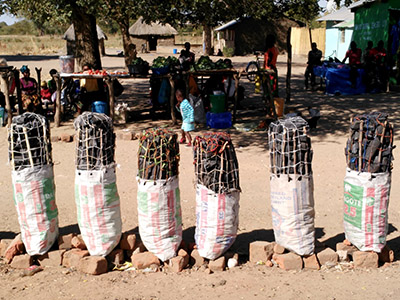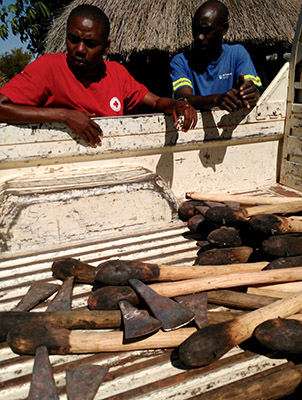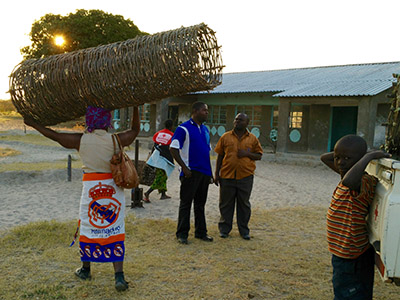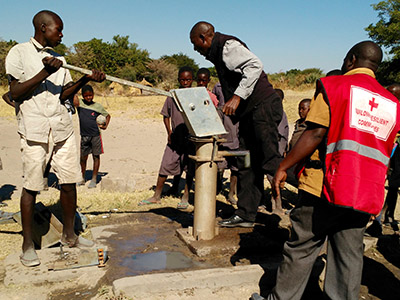 |
 |
 |
 |
notes from the field
These field notes are personal views and do not necessarily reflect the views of Red Cross/Red Crescent Climate Centre
Sierra Gladfelter
Zambia
June 3 - August 23, 2016
Community Action Plans: Learning the Art of Compromise in Serving Local Visions
July 2016
View photo gallery for more photos from the field by Sierra Gladfelter
 As we dodge potholes on the highway from Kazungula to Sesheke, the bush smolders on the shoulders of the road. Men pause in the heat of the day from clearing brush, squatting in small patches of shade on the side of the road. When I ask the Zambia Red Cross Society (ZRCS)’s Disaster Management Officer, Samuel Mutambo, seated beside me about the fires, his brow furrows. We are in the midst of a week monitoring activities associated with the Building Resilient African Communities (BRACES) program supported by the American Red Cross and are on our way to check on communities and deliver materials for the implementation of local action plans in Kazungula and Mwandi districts. Samuel, still troubled by the sight outside our window, launches into a thoughtful explanation. The forest burning is common here I come to learn, along with many other areas of Sub-Saharan Africa. According to Zambia’s Energy Regulation Board, approximately 75% of Zambians live off the grid without electricity (a rate that rises to 95% in rural areas), where firewood serves as one of their only forms of fuel, heat, and light.
As we dodge potholes on the highway from Kazungula to Sesheke, the bush smolders on the shoulders of the road. Men pause in the heat of the day from clearing brush, squatting in small patches of shade on the side of the road. When I ask the Zambia Red Cross Society (ZRCS)’s Disaster Management Officer, Samuel Mutambo, seated beside me about the fires, his brow furrows. We are in the midst of a week monitoring activities associated with the Building Resilient African Communities (BRACES) program supported by the American Red Cross and are on our way to check on communities and deliver materials for the implementation of local action plans in Kazungula and Mwandi districts. Samuel, still troubled by the sight outside our window, launches into a thoughtful explanation. The forest burning is common here I come to learn, along with many other areas of Sub-Saharan Africa. According to Zambia’s Energy Regulation Board, approximately 75% of Zambians live off the grid without electricity (a rate that rises to 95% in rural areas), where firewood serves as one of their only forms of fuel, heat, and light.
"While rural Zambians often shoulder the blame for statistics on the growing rate of deforestation (according to the Times of Zambia, now approaching 300,000 hectares per year), the reality is not so simple." |
 Even in Lusaka, Zambia’s rapidly developing capital, people who live with modern conveniences and access to more sustainable fuel alternatives often choose charcoal for cooking traditional dishes over their outdoor charcoal stoves. This urban consumption of forest resources has been exacerbated by the growing frequency of power cuts and load-shedding in urban areas which leaves vast swathes of Lusaka without power on a daily basis. Getting a meal on the table often means lighting up a bag of charcoal. Rural communities, like those along the road between Sesheke and Kazungula, serve as suppliers in a market currently estimated to be worth more than US $100 million (Ngosa, 2014).
Even in Lusaka, Zambia’s rapidly developing capital, people who live with modern conveniences and access to more sustainable fuel alternatives often choose charcoal for cooking traditional dishes over their outdoor charcoal stoves. This urban consumption of forest resources has been exacerbated by the growing frequency of power cuts and load-shedding in urban areas which leaves vast swathes of Lusaka without power on a daily basis. Getting a meal on the table often means lighting up a bag of charcoal. Rural communities, like those along the road between Sesheke and Kazungula, serve as suppliers in a market currently estimated to be worth more than US $100 million (Ngosa, 2014).
The Zambia Red Cross Society (ZRCS)’s BRACES project seeks to combat such ‘destruction of the environment’ by empowering communities to manage local forest and land resources in ways that build rather than erode their resilience. While this aim is noble, its implementation is not always so straightforward on the ground, particularly when the approach depends on residents identifying their own needs through community action plans. This becomes evident during our first stop in a cluster of huts in the community of Sikaunzwe. We are delivering axes to the local head of the Satellite Disaster Management Committee (SDMC), so that remote communities gardening in the bush could clear a track to the main road to get their goods to market. Not having known exactly what we were delivering, I have to laugh at the profound irony as we, as part of a climate resilience intervention, stack hatchets in the shade of a hut that also has dozens of bags of charcoal waiting to be carried to the highway. I ask Samuel, trying to suppress the doubt in my voice, how we know that the axes will be used to clear the road and not in the production of local charcoal (certainly more profitable than selling tomatoes and okra!).
 Samuel laughs. He knows where I am going. He assures me that the axes will be used for widening the road so that buyers may better access the vegetables grown through the BRACES program. Here, SDMCs carefully manage the tools they are provided and they cannot just be used for anything. Still, even Samuel admits that the possibility of the axes being used for other means remains. This, however, is the compromise he and others must be willing to make if they take seriously the self-proclaimed needs of communities. They have to learn to trust in order to build a reciprocal exchange with communities. The longer I have time to reflect on my own internal conflict over distributing axes, which could very well be used to exacerbate the forest’s felling, however, the less crazy it feels. Anything less than this commitment to local self-determination, I came to realize, would be paternal and colonial, another unidirectional intervention rooted in ‘education’ and coercion that so often occurs in the development industry and that the ZRCS works hard not to reproduce. When they give a community tools, they never have full control over how the community uses them. In the end, the lesson becomes about having a relationship that does not breed doubt but trust.
Samuel laughs. He knows where I am going. He assures me that the axes will be used for widening the road so that buyers may better access the vegetables grown through the BRACES program. Here, SDMCs carefully manage the tools they are provided and they cannot just be used for anything. Still, even Samuel admits that the possibility of the axes being used for other means remains. This, however, is the compromise he and others must be willing to make if they take seriously the self-proclaimed needs of communities. They have to learn to trust in order to build a reciprocal exchange with communities. The longer I have time to reflect on my own internal conflict over distributing axes, which could very well be used to exacerbate the forest’s felling, however, the less crazy it feels. Anything less than this commitment to local self-determination, I came to realize, would be paternal and colonial, another unidirectional intervention rooted in ‘education’ and coercion that so often occurs in the development industry and that the ZRCS works hard not to reproduce. When they give a community tools, they never have full control over how the community uses them. In the end, the lesson becomes about having a relationship that does not breed doubt but trust.
Having studied the limits of local participation in resilience interventions in distant river basins in Nepal and India, I find the ZRCS’s commitment to local visions in rural Zambian communities inspiring. Community needs are being identified by the people who know their own vulnerability best, and the ZRCS functions primarily as a facilitator, doing its best to provide materials for activities that communities propose while encouraging independent replication and the innovation of local solutions that do not require outside assistance.
 During the course of our week in the field, in addition to handing out axes, we also deliver timber and tin to construct toilets for the elderly, renovate an abandoned bore well to provide water access at a local school, and distribute bags of sawdust to be used in the construction of fuel-efficient stoves. Here, I learn, in the loamy soils of the Zambezi River’s floodplains, drinking water is often brackish and toilets collapse constantly in the easily erodible sand. The large tubular baskets we carry lashed to the back of the pick-up truck will be lined with plastic and used by the community to construct stable outhouses that are less likely to pollute the water table.
During the course of our week in the field, in addition to handing out axes, we also deliver timber and tin to construct toilets for the elderly, renovate an abandoned bore well to provide water access at a local school, and distribute bags of sawdust to be used in the construction of fuel-efficient stoves. Here, I learn, in the loamy soils of the Zambezi River’s floodplains, drinking water is often brackish and toilets collapse constantly in the easily erodible sand. The large tubular baskets we carry lashed to the back of the pick-up truck will be lined with plastic and used by the community to construct stable outhouses that are less likely to pollute the water table.
As I stand in the sun, watching the school children of Situlu, half of whom are barefoot, assemble in a knot watching for over an hour until their broken pump once again draws water, I am struck by the simplicity of the actions we call “building resilience.” Fixing a water pump, building a toilet, providing chickens that can sustainably reproduce a local source of protein. I say this not to belittle the important work that the ZRCS and its donors are doing in these communities.
"Rather to highlight the fact that building resilience must not be romanticized. In most parts of the world resilience is not grand, a single transformative act, nor a project that swoops in and leaves people supposedly ‘secure.’ Rather, building resilience from the ground in places like Zambia and across the developing world is more often a modest endeavor: a long process of taking steps toward bringing people the things that so many of us in the world have already come to take for granted." |
It is humility I now feel when we drive past bags of charcoal for sale by men and women squatting on the side of the road. While the current rates of deforestation sweeping rural Zambia are certainly of concern and warrant intervention, how exactly this is carried out is important. We, as both academics studying these interventions and development/humanitarian workers contributing directly to them, should be careful about the way in which we position blame and the assumptions we make about people’s economic alternatives. When it comes down to it, people use charcoal and depend on selling it to a growing urban population to feed their families. Any intervention must be grounded in this reality.
"Certainly if we expect people in the bush to change their livelihoods, to find other sources of income than supplying charcoal to urban markets, then it seems to me that all of us—particularly wealthy Lusakans and Americans supporting such interventions—should also consider the ways in which resilience, even in the thickets of rural Zambia, requires all of us to change. This includes how much we consume, what we eat, and when faced with climate change, the moral stories we tell of who needs to transform their way of living." |
Responsibility for both climate change and its solutions falls much further than upon the shoulders of a man with an axe.
References
Ngosa, S. (2014, November 20). Exploring New Forms of Cooking Energy. Times of Zambia.

